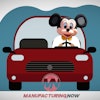It’s a bird! It’s a plane! It’s a speeding forklift? While it may be an effective way to load and unload a truck, a forklift can also be the main cause of workplace injuries.
Some of the most common accidents include lateral tip-overs—where the operator can be injured or killed trying to jump off an overturning forklift—and accidents where the forklift strikes an employee, product, or part of the facility.
By taking a few additional safety steps, most of these accidents can be prevented.
Whether it’s because of emissions or size constraints, some of the most common forklifts have electric, rather than internal combustion motors. These electric-powered forklifts can be particularly dangerous, as they are extremely quiet. Other employees may be unaware that there is a forklift in the area, increasing the possibility of an accident.
As a safety precaution, these forklifts should be fitted with headlights and backup and motion alarms, said Pat Huebel with Toyota Material Handling.
Speed can be a big factor in forklift accidents. If the operator is traveling too fast, they may tip going around a corner or be unable to avoid striking someone or something. Huebel suggests taking the issue of speed out of the operators’ hands by controlling it with speed limiters. Making it impossible to exceed a certain speed reduces the possibility of human error causing an accident.
“Training is key,” Huebel added, recommending that not only operators receive training, but also their supervisors and any other personnel that may be in an area where a forklift will be in operation. Additional training would make it clear to all involved what can and cannot be done with a forklift, as well as what the operator can and cannot see while maneuvering the forklift. The result is a safer workplace where violations can be spotted easily and employees know how to keep themselves safe.
Training is important at New Penn Motor Express, according to vice president of human resources and safety, Andy Kerlik. Should an accident occur, both the operator and their supervisor must complete an accident investigation report. The person who caused the accident may face disciplinary action and they must be retrained in forklift use.
New Penn also has “near miss” reports to evaluate a situation in order to prevent it—or something worse—from happening again. Additionally, new hires have skills tests and training before they are allowed to operate the forklift.
Better still for the operator, today’s forklifts aren’t your father’s forklifts. In an effort to keep workers safe, forklifts have undergone several safety changes.
Toyota Material Handling, for example, uses System of Active Stability (SAS). SAS senses factors that lead to instability and engages a Swing Lock Cylinder to stabilize the rear axel. That changes the truck’s stability footprint from triangular to rectangular in shape. The increased stability decreases the chances the lift truck will overturn. Since its introduction in 1999, there have been no fatalities from lateral overturns on Toyota lift trucks quipped with the SAS.
Regardless of design changes and safety devices, however, manufacturers must still be aware of human error as a potential safety hazard. It has serious, potentially fatal consequences that must be addressed.
“It all comes back to training,” said Huebel.
Kerlik agrees, adding, “Forklift and operator safety leads to good product safety, which is a win-win situation for everyone.”






















